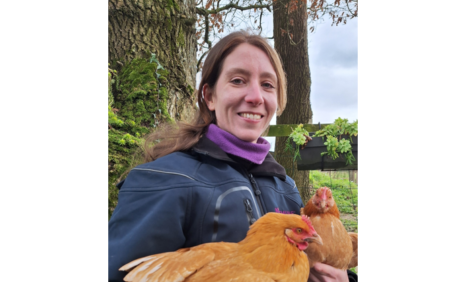



Foot Problems Found in 40 Per Cent of Hens in Non-Cage Systems
In their presentation at the 8th European Symposium on Poultry Welfare, K. Niebuhr and collegues from the University of Veterinary Medicine in Vienna, Austria, reported finding foot pad dermatitis in an average of 40 per cent of hens housed on free-range or deep litter systems.Foot pad dermatitis in chickens may vary from superficial lesions accompanied by hyperkeratosis to profound lesions affecting not only the epidermis but as well the underlying tissue accompanied by acute or chronic inflammations and ulceration.
Although foot pad dermatitis has gained considerable attention in broilers, little attention has been paid so far to foot pad dermatitis in laying hens. Only a few studies regarding the prevalence of foot pad dermatitis in laying hens or possible influencing factors are available. The aim of this study by the researchers from Vienna was to evaluate data gathered in laying hen holdings in Austria to gain new information about this welfare problem.
Data obtained during farm visits of 297 laying hen flocks (aged 18 to 83 weeks) kept in free-range (n=234, of which 103 were organic) and deep litter systems (n=65) were used for the evaluation.
During these visits, system and management characteristics were recorded.
Foot pads of both feet of 20 randomly selected hens in each flock were visually inspected for the occurrence of ulcerative foot pad dermatitis (Y/N) and the percentage of hens with these lesions was calculated per flock. Data were analysed with the help of SPSS software using the Spearman rank correlation and the Mann- Whitney-U test.
Ulcerative foot pad dermatitis was found on median in 40 per cent of hens per flock (mean = 38.75 per cent; STD=23.29 per cent; minimum = 0 per cent; maximum = 95 per cent).
Formation of foot pad dermatitis was influenced by hybrid (p<0.001), age (rs=0.17, p=0.003) and average weight of hens (rs=0.17, p=0.003).
Regarding housing conditions, both flock size (rs=0.12, p=0.03) and stocking density (rs=0.15, p=0.009) showed a positive correlation as did dimension (height) of perches (rs=0.15, p=0.02, n=241).
Compared with results in the literature, the incidence of foot pad dermatitis seems to be slightly higher in the non-cage flocks surveyed. For instance, Rönchen et al. (2007) found in three flocks between 25 and 37 per cent of aviary hens with foot pad lesions.
Dr Niebuhr and his colleagues conclude that their evaluation found some indications of influencing factors but they suggested further research to understand the complex interactions between housing conditions and foot pad dermatitis in order to be able to reduce the number of hens affected.
Reference
Niebuhr, K., C. Arhant, A. Lugmair, B. Gruber and K. Zaludik. 2009. Foot Pad Dermatitis in Laying Hens Kept in Non-Cage Systems in Austria. Proceedings of 8th Poultry Welfare Symposium, Cervia, Italy, 18-22 May 2009, p8.
Further Reading
| - | You can see other papers presented at the 8th European Symposium on Poultry Welfare by clicking here. |
February 2010









